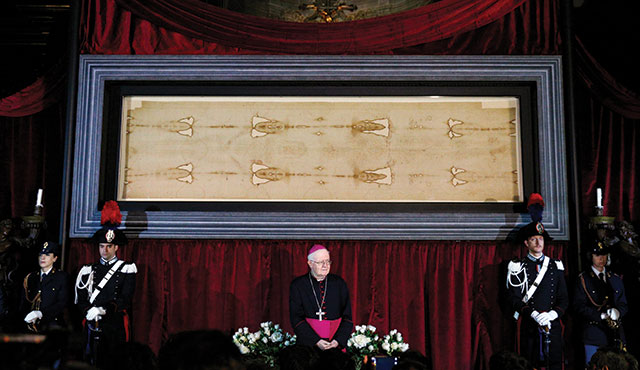Modern science has completed hundreds of thousands of hours of detailed study and intense research on the Shroud of Turin. It is, in fact, the single most studied artifact in human history, and we know more about it today than we ever have before. And yet, the controversy still rages.
The Shroud of Turin, also called Holy Shroud, is a length of linen that for centuries is purported to be the burial garment of Jesus Christ. It has been preserved since 1578 in the royal chapel of the cathedral of San Giovanni Battista in Turin, Italy. Measuring 14 feet 3 inches long and 3 feet 7 inches wide, it portrays two faint brownish images, those of the back and front of a gaunt, sunken-eyed, 5-foot 7-inch man—as if a body had been laid lengthwise along one half of the shroud while the other half had been doubled over the head to cover the whole front of the body from face to feet. The images contain markings that correspond to the crucifixion wounds of Jesus, including thorn marks on the head, lacerations, as if from flogging, on the back, bruises on the shoulders, and various stains of what is presumed to be blood. The Shroud of Turin is distinct from the Veil of Veronica, which is depicted in the Stations of the Cross as a piece of fabric that was imprinted with Christ’s face during his walk to Golgotha.
The Shroud has been publicly exhibited only rarely, as, in recent times, on the marriage of Prince Umberto (1931) and on the 400th anniversary of its arrival in Turin (1978). In 1998 and 2000 Pope John Paul II arranged for public viewings; he called the shroud “a mirror of the Gospel.” Pope Benedict XVI similarly arranged a public display in 2010, and Pope Francis made a pilgrimage to see it in 2015.
Can science prove that this burial shroud, imprinted with marks that reflect the wounds of crucifixion, was used to cover Jesus of Nazareth? On October 4, two renowned experts on the Shroud of Turin will explore that very question with compelling presentations.
In his presentation on the Shroud of Turin, Father Spitzer will skillfully point out a significant flaw in the 1988 carbon testing that dated the origin of the Shroud to the middle ages. He then discusses new data that strongly suggests that not only is the Shroud a first century artifact but quite possibly a relic of the resurrection.
Joseph Marino, a former Benedictine monk, has been studying the Shroud of Turin since 1977. He presented a paper at the Sindone 2000 World Congress in Orvieto, Italy, hypothesizing that the reason the 1988 C-14 dating of the Shroud resulted in a date range of AD 1260-1390 for the cloth was because of a sixteenth-century repair in the sample area. Marino is the author of “Wrapped in the Shroud: Chronicle of a Passion.”
Father Robert J. Spitzer is a Jesuit priest, philosopher, educator, author, speaker, and former President of Gonzaga University. He is founder and currently active as president of the Magis Center of Reason and Faith. In 2010 Fr. Spitzer defended God’s existence against physicist Stephen Hawking on CNN’s “Larry King Live.”
Event details
For more information, log on to https://www.rcbo.org/events/science-and-the-shroud-of-turin/

